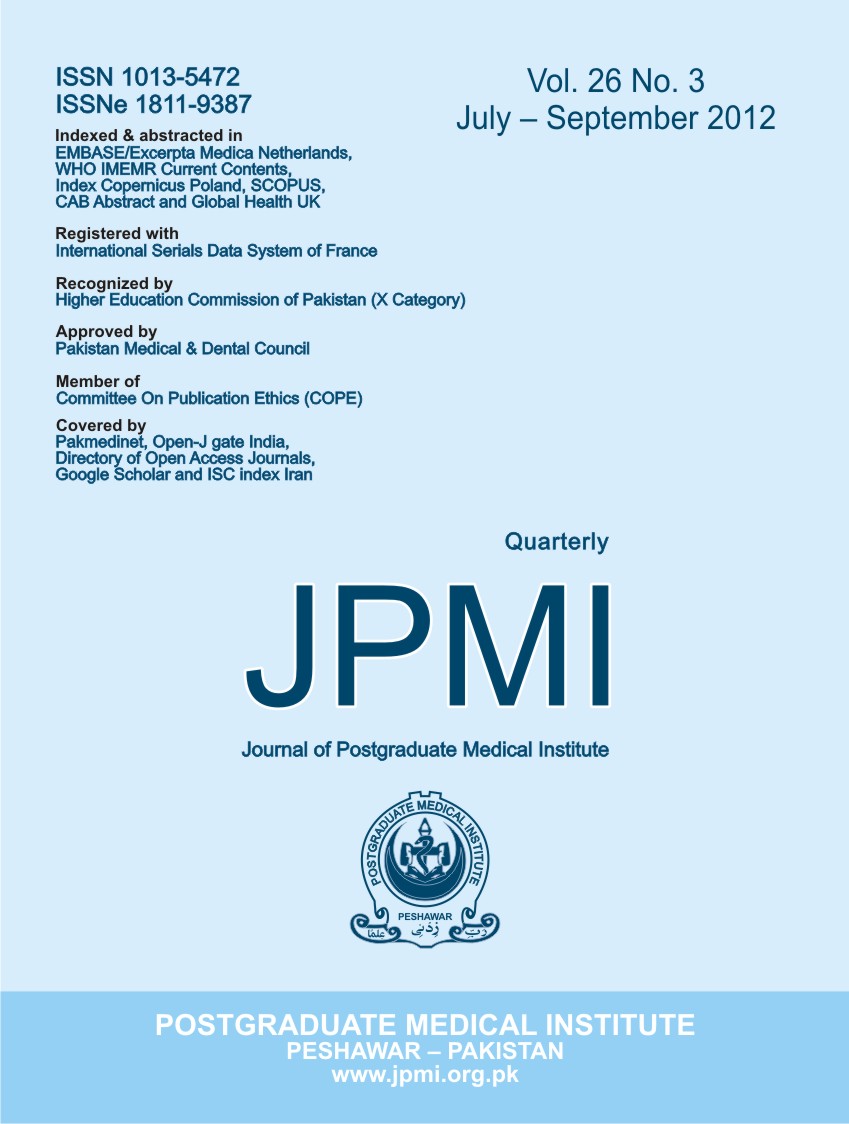PREVALENCE OF HUMAN MALARIA INFECTION IN BORDERING AREAS OF BALOCHISTAN WITH SINDH PROVINCE: DISTRICT JAFFARABAD
Main Article Content
Abstract
Objective: The present study was designed to assess the prevalence of malarial infections in human
population of district Jaffarabad, the hottest areas of Balochistan, Pakistan.
Methodology: The study was conducted in district Jaffarabad (10 localities) from July, 2006 to June, 2008.
Malarial parasites were identified in the blood slides of 6283 suspected patients of the disease.
Results: Out of 6283 suspected cases of malaria, 2968 (47.2%) were found to be positive for malarial
parasite in blood smear slides. Out of positive cases, 2407 (81%) were identified as Plasmodium vivax
infection, 561 (18.9%) cases with P. falciparum. However, seasonal variation was also noted with the
highest (250/274) infection of P. vivax in April and lowest (172/249) in December. The prevalence was
higher (77.9%) in males. Age wise, the prevalence of the disease was 84.3% in the age group of 1-10 years
and 81% in the age group of 11-20 years. There was no case of P. malariae and P. ovale detected in the
present study. No association was found between types of infection and age groups.
Conclusion: In clinically suspected cases of malaria, slide positivity rate is high. The high prevalence rate
of P. vivax poses a significant health hazard but of P. falciparum also may lead to serious complications
like cerebral malaria. The high frequency of human malaria infection should be of great concern for
authorities at malaria control program in Pakistan.
population of district Jaffarabad, the hottest areas of Balochistan, Pakistan.
Methodology: The study was conducted in district Jaffarabad (10 localities) from July, 2006 to June, 2008.
Malarial parasites were identified in the blood slides of 6283 suspected patients of the disease.
Results: Out of 6283 suspected cases of malaria, 2968 (47.2%) were found to be positive for malarial
parasite in blood smear slides. Out of positive cases, 2407 (81%) were identified as Plasmodium vivax
infection, 561 (18.9%) cases with P. falciparum. However, seasonal variation was also noted with the
highest (250/274) infection of P. vivax in April and lowest (172/249) in December. The prevalence was
higher (77.9%) in males. Age wise, the prevalence of the disease was 84.3% in the age group of 1-10 years
and 81% in the age group of 11-20 years. There was no case of P. malariae and P. ovale detected in the
present study. No association was found between types of infection and age groups.
Conclusion: In clinically suspected cases of malaria, slide positivity rate is high. The high prevalence rate
of P. vivax poses a significant health hazard but of P. falciparum also may lead to serious complications
like cerebral malaria. The high frequency of human malaria infection should be of great concern for
authorities at malaria control program in Pakistan.
Article Details
How to Cite
1.
Yasinzai MI, Kakar JK. PREVALENCE OF HUMAN MALARIA INFECTION IN BORDERING AREAS OF BALOCHISTAN WITH SINDH PROVINCE: DISTRICT JAFFARABAD. J Postgrad Med Inst [Internet]. 2012 Jun. 29 [cited 2025 Dec. 5];26(3). Available from: https://jpmi.org.pk/index.php/jpmi/article/view/1301
Issue
Section
Original Article
Work published in JPMI is licensed under a
Creative Commons Attribution-NonCommercial 2.0 Generic License.
Authors are permitted and encouraged to post their work online (e.g., in institutional repositories or on their website) prior to and during the submission process, as it can lead to productive exchanges, as well as earlier and greater citation of published work.


